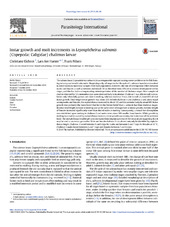| dc.contributor.author | Eichner, Christiane | eng |
| dc.contributor.author | Hamre, Lars Are | eng |
| dc.contributor.author | Nilsen, Frank | eng |
| dc.date.accessioned | 2015-09-22T12:04:08Z | |
| dc.date.available | 2015-09-22T12:04:08Z | |
| dc.date.issued | 2015-02 | |
| dc.identifier.issn | 1383-5769 | en_US |
| dc.identifier.uri | http://hdl.handle.net/1956/10496 | |
| dc.description.abstract | The salmon louse (Lepeophtheirus salmonis) is an ectoparasitic copepod causing severe problems to the fish farming industry and to wild salmonids. Morphologically, all stages in the life cycle of L. salmonis have been described in detail based on successive samples from host populations. However, the rate of development differs between males and females as well as between individuals. It has therefore been difficult to observe development within stages, and this has led to a longstanding misinterpretation of the number of chalimus stages. Here samples of chalimi obtained for 12 consecutive days were observed daily in incubators. Chalimus 1 was able to molt in incubators only when fully grown and close to molting, whereas chalimus 2 was able to molt at about 60% of total instar growth. Total length instar growth was about 35% in both chalimus 1 and chalimus 2 and about equal among males and females; the cephalothorax increased by about 12% and the posterior body by about 80%. Instar growth was probably the main factor that led to the former belief that L. salmonis had four chalimus stages. Relative total length increase at molting was at the same order of magnitude as instar growth, but total length of females increased significantly more than that of males at molting. Consequently, a sexual size dimorphism was established upon molting to chalimus 2 and males were about 10% smaller than females. While growth by molting was mainly caused by cephalothorax increase, instar growth was mainly due to increase of the posterior body. The cephalothorax/total length ratio decreased from beginning to end of the instar phase suggesting that it may be used as an instar age marker. Male and female chalimus 2 can almost uniquely be identified by cephalothorax length. Chalimus 1 lasted between 5 and 6 days for males and between 6 and 7 days for females at 10 °C. Chalimus 2 males lasted between 6 and 7 days and females between 7 and 8 days. | en_US |
| dc.language.iso | eng | eng |
| dc.publisher | Elsevier | en_US |
| dc.rights | Attribution CC BY-NC-ND | eng |
| dc.rights.uri | http://creativecommons.org/licenses/by-nc-nd/3.0/ | eng |
| dc.subject | Ecdysis | eng |
| dc.subject | Frontal filament | eng |
| dc.subject | Molt | eng |
| dc.subject | Cuticle | eng |
| dc.subject | Duration | eng |
| dc.subject | Salmon louse | eng |
| dc.title | Instar growth and molt increments in Lepeophtheirus salmonis (Copepoda: Caligidae) chalimus larvae | en_US |
| dc.type | Peer reviewed | |
| dc.type | Journal article | |
| dc.date.updated | 2015-06-29T08:59:15Z | |
| dc.description.version | publishedVersion | en_US |
| dc.rights.holder | Copyright 2014 The Authors | en_US |
| dc.identifier.doi | https://doi.org/10.1016/j.parint.2014.10.006 | |
| dc.identifier.cristin | 1214872 | |
| dc.source.journal | Parasitology international | |
| dc.source.40 | 64 | |
| dc.source.14 | 1 | |
| dc.source.pagenumber | 86-96 | |
| dc.subject.nsi | VDP::Landbruks- og fiskerifag: 900::Fiskerifag: 920::Fiskehelse : 923 | |
| dc.subject.nsi | VDP::Agriculture and fisheries science: 900::Fisheries science: 920::Fish health: 923 | |
| dc.subject.nsi | VDP::Matematikk og naturvitenskap: 400::Basale biofag: 470::Generell mikrobiologi: 472 | |
| dc.subject.nsi | VDP::Mathematics and natural scienses: 400::Basic biosciences: 470::General microbiology: 472 | |

